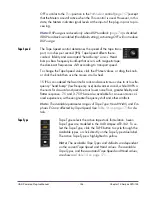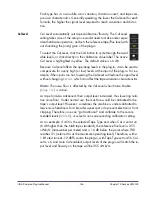
UAD Powered Plug-Ins Manual
- 154 -
Chapter 12: Ampex ATR-102
When Link is active, automation data is written and read for the left channel
only. In this case, the automation data for the left will control both channels.
Additionally, changing the right channel parameters from a control surface or
when in “controls only” (non-GUI) mode will have no effect.
Unlink
When Unlink is active, the controls for the left and right channels are indepen-
dent. When unlinked, automation data is written and read by each channel
separately.
Emphasis EQ
The Emphasis EQ buttons determine the active Emphasis EQ
values and the frequency of the Hum noise. NAB or CCIR
curves can be selected when the Tape Speed is 7.5 or 15
IPS. When the Tape Speed is 30 IPS, neither value is avail-
able (the LEDs are dimmed) because the EQ is fixed with the
AES emphasis curve, per the original hardware. At 3.75 IPS, only NAB is
available (as it is with the hardware).
When the value is set to NAB (traditionally the United States standard), the
Hum Noise frequency is 60 Hz. When set to CCIR (traditionally the standard
in Europe and other regions), the Hum Noise frequency is 50 Hz. See
“Noise
Enable” on page 161
and
“Hum” on page 161
for more information about
Hum.
Tape Speed and Emphasis EQ were originally practical controls for recording
duration versus noise and local standards. Historically, the origin of the tape
machine (US or European) dictated the built-in EQ emphasis, but later ma-
chines like the Ampex ATR-102 had both circuits available.
CCIR (also known as IEC1) is the EQ pre-emphasis made famous on British
records and is considered the technically superior EQ; many say this EQ was
part of the “British sound” during tape’s heyday. NAB (also known as IEC2)
was the American standard with its own sound. AES is truly standardized at
30 IPS and is the sole EQ found on the Ampex ATR-102 at 30 IPS.
Power
Power is the plug-in bypass control. When set to OFF, em-
ulation processing is disabled, the Meters and control LEDs
are dimmed, the Bypass LED illuminates, and DSP usage is
reduced. Power is useful for comparing the processed settings to the original
signal.
















































